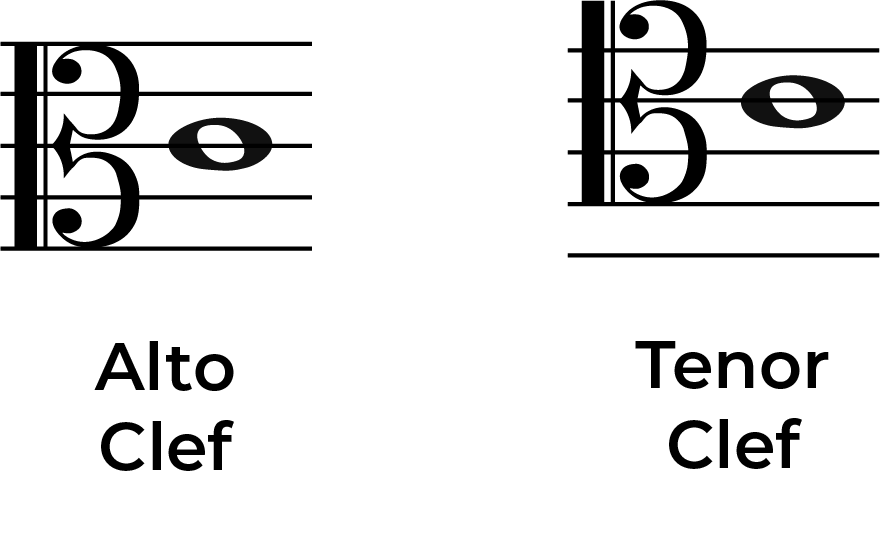The bass clef is perhaps one of the most common clefs out there. If you play the piano you will most likely see this on the bottom line of your staff as it is used for the left hand notes.
If you would like to learn bass clef notes then read this blog post carefully as we will teach you how to read the bass clef note names and build up your bass clef skills.
A clef is a symbol written at the beginning of staff lines. This symbol helps to determine a pitch for each line and space and therefore helps the performer to know what notes to play. The staff represents the music a composer would like the performer to play and by placing a clef at the start of the staff, each line and space will have an assigned pitch. The bass clef staff is simply a staff that has a bass clef at the start.
What is a bass clef?
The bass clef is used for low pitched notes, i.e. notes below middle C. The bass clef is also sometimes called the F clef because it shows where the note F is on the staff lines, specifically the F just below middle C.
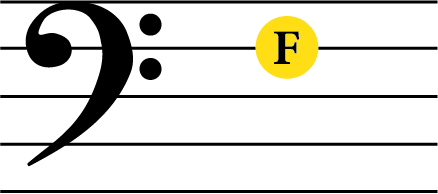
If you find middle C you can easily count down from there to find out the notes in the bass clef staff. Having reference notes, such as this middle c will make it much easier to read the notes, whether these are bass notes or treble notes.
The bass clef staff will have five lines and four spaces.
What Are The 7 Musical Notes on the Bass Clef Staff?
The bass clef notes are, from the bottom line to the top line, as follows:
G, A, B, C, D, E, F, G, A
Notice how once we get to the G the musical alphabet repeats again.

You can also count the bass clef notes from middle C and the same musical notation pattern will be followed.

How to Remember Bass Clef Notes
As you can see above, every note is either on a line or in a space. If you separate these out it is much easier to remember and read bass clef notes.
Below you can see the line notes:

Below you can see the space notes:
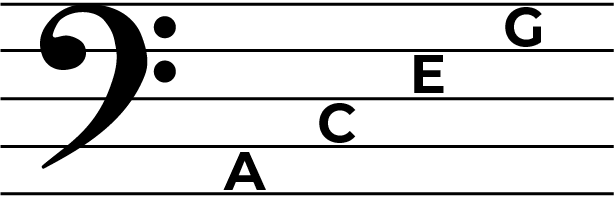
There are some very easy way to help you remember these lines and spaces note names and these are different mnemonic devices.
Line notes Mnemonic
For the notes on the lines, we can use the mnemonic device – Good Boys Do Fine Always. This rhyme goes from bottom to top on the five lines and the lines correspond with the mnemonic above. The bottom line will be G ‘good’, the second line will be B ‘boys’, the third line will be D ‘do’, the fourth line will be F ‘fine’ and the top line will be A ‘always’.
I always find this is an awkward mnemonic as it is so similar to the treble clef one but it works! If you can memorize these different rhymes you will find it very easy to read the bass notes.

Space Notes Mnemonic
For the space notes we can remember All Cows Eat Grass. This mnemonic also goes from bottom to top just as we saw with the line notes. The bottom space is ‘A’, the second space is ‘C’, the third space is ‘E’ and the fourth space is ‘G’.

By using these rhymes you will be able to learn how to quickly read bass clef notes.
Line Note Reading Practice
Want to do some bass clef line note reading practice? Take a look at the short piece of sheet music below and see if you can read the note on the lines in bass clef notation. Remember to use the mnemonic ‘good boys do fine always’ to help you read these music notes.

The answers are:
G, B, G, B, F, A, D, B, D, F, B
Space Note Reading Practice
Want to do some bass clef space note reading practice? Take a look at the short piece below and see if you can read the bass clef note names. Remember to use the mnemonic ‘all cows eat grass’ to help you read these music notes.

The answers are:
A, C, A, C, G, E, E, G, B, G, C
How To Draw A Bass Clef Properly
The bass clef is not as tricky to draw as the treble clef you will be relieved to know!
At the start of your five staff lines draw a spot on the second line down from the top. You will then curve your pencil up and then down to the bottom of the staff. To finish this off you will draw two dots either side of that second line. These two dots literally frame the note F, giving the bass clef it’s alternative name the F clef.
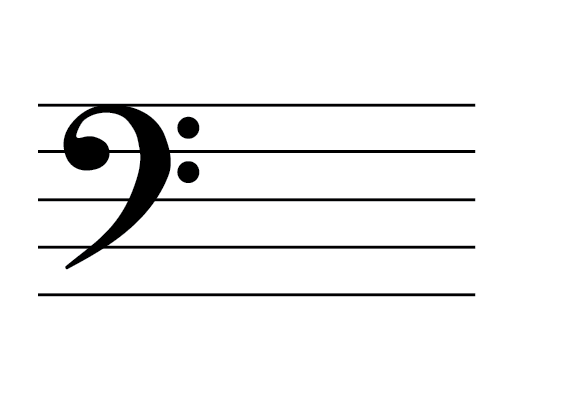
Below you can see the steps to drawing the bass clef.

Grab some paper and give it a go!
What Instruments Use The Treble Clef?
The bass clef is used for many instruments some good examples of these are:
- Bassoon
- Cello
- Double Bass
- Trombone
- Tuba
- Left hand of the piano keyboard
Although this list in not exhaustive, it is important to recognise what all of these instruments have in common. What they have in common is that all of these instruments play notes below middle C.
Middle C is a note that uses one ledger line right at the top of the bass clef staff.
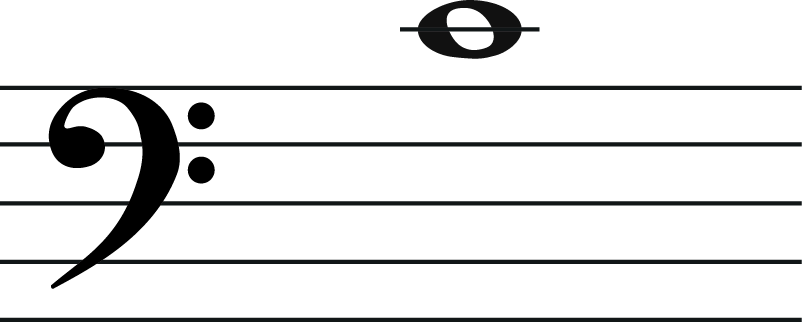
Ledger lines are short lines that are placed outside of the usual staff lines to add extra notes.

Other instruments will use different clefs, such as the treble clef, alto clef or tenor clef.
Musical Staff and the Piano
As we have seen, the piano is one of the instruments that uses the bass clef. However, when playing the piano we don’t just read notes only in the bass clef.
As we have seen, the bass clef is for notes written above below C (the notes in the left hand). But the piano has a much larger range than this.
In order to read this large range, the piano also uses the treble clef. Treble clefs are used for notes above middle C and is therefore the notes that will be played by the right hand. In the case of a treble clef, the middle C will be written at the bottom of the staff. It will still use a ledger line, but this time it will be at the bottom. Remember, ledger lines are the extra short lines written above or below the usual staff lines.

Take a look at the piano keyboard below and you can see where middle C is on the keyboard.
Want to Learn More About Music?
If you want to continue learning more about musical notation and the different clefs in music theory, then make sure to check out the next steps.
The best place to look next is to learn what is the treble clef and how to read music notation in the treble clef. If you can read treble clef you will find it much easier to play the piano!
There are of course other clefs in music notation and these are:
- Alto clef
- Tenor clef
The alto clef and the tenor clef are much less common than the treble clefs and bass clefs, but they are still important to learn none the less!
